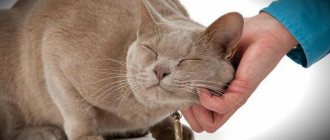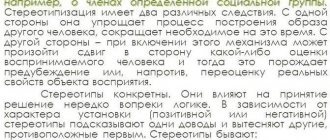Sociometry in psychology is a method for studying interpersonal relationships in a group. The author of the direction is J. Moreno. The psychotherapist has developed both a separate technique with a similar name for studying groups, and an entire direction. In a broad sense, sociometry is a set of methods for studying relationships in a group. Let's take a closer look at what sociometry is, when and what it is used for, and how to use sociometric research correctly. We will also define the basic concepts and procedures of the sociometry method.
Definition of the concept
The name “sociometry” is derived from two Latin words: socius, which translates as “comrade, companion, accomplice”, and metrim, which means “measurement”. Thus, literally “sociometry” is translated as “measurement of accomplices.” Sociometry is an applied science that is based on psychological, sociological teachings and does not have a unique status.
Who developed the sociometry method? The author of the theory and research methodology is psychologist, sociologist and psychiatrist J. Moreno. The researcher believed that all social problems can be solved by regulating relationships between people. However, for this it is necessary to determine the nature of interpersonal and intergroup relations. For this purpose, the sociometry method was created. Sociometry is based on group psychotherapy.
What process is sociometry used to study? Sociometry is a method of psychological research that is used to describe and study interpersonal relationships in a team. Sociometry allows you to collect primary information about a small social group for further analysis. The cause of the conflict, according to sociometry, is the difference in people’s beliefs and contradiction in emotional relationships.
Interesting! Moreno first used the concept of “sociometry” while working in a refugee camp. Then the psychologist suggested that fewer conflicts and contradictions would arise between people if they were settled not chaotically, but according to nationality, religious and political beliefs, and other interests.
Sociometric theory of J. Moreno
The young doctor Jacob Moreno Levi began his research during the First World War in a refugee camp near Vienna. He noticed that the effectiveness of people’s interactions depends on who they are currently in contact with. In some cases, communication is colored by positive emotions, and people interact with pleasure, in others, the effect of rejection arises, and partners literally lose everything.
Based on observations, Moreno came to the conclusion that society is subject to the same laws of attraction and repulsion as the physical world. Therefore, in any community there are people who are drawn to each other and strive to unite in microgroups of 3-4 people. These micro-groups play an important role in the functioning of the entire community. His life is also greatly influenced by those individuals who have the gift of attraction and who are sympathized with other members of the group.
Having emigrated to the USA, J. Moreno continued his research at a specialized school for juvenile delinquents, and then even opened the Sociometric Institute. By the mid-40s, Moreno’s teaching had fully taken shape, and the author himself distinguished three directions in it: sociometry, sociodrama and psychodrama.
The purpose of sociometry
The purpose of sociometry as a research method in psychology is to improve and optimize the interaction of those individuals who are part of the group being examined. Objectives of sociometry:
- Determine the degree of cohesion or disunity between team members.
- Identify authoritative people, likes and dislikes within the group.
- Discover mini-unions within a large team, led by informal leaders.
Sociometry is resorted to if there are noticeable signs of an unfavorable psychological climate in the team, disunity of participants, conflicts, contradictions, decreased performance and productivity. The data obtained during sociometry can be used for further restructuring of the team. The overall result and achievement of common goals depends on the cohesion of the group.
Important! Sociometry indicates likes and dislikes within a team, but does not name specific problems. To more accurately determine psychological problems and eliminate them, it is necessary to use additional diagnostic techniques, for example, conversation, surveys, projective tests.
Group Emotional Expansiveness Index
Group sociometric indices
Index of emotional expansiveness of group member j
The index of emotional expansiveness of the j-member of the group is calculated using the formula:
where Ej
– emotional expansiveness
the j
-member,
R
– choices made
the j
-member (+, –).
From a psychological point of view, the indicator of expansiveness characterizes the individual’s need for communication.
Among the group sociometric indices, the most important are:
- group emotional expansiveness index;
- index of psychological reciprocity in the group (group cohesion);
The group’s emotional expansiveness index is calculated using the formula:
where Ag
– expansiveness of the group,
N
– number of group members.
The index shows the average activity of the group when solving a sociometric test task (per each group member).
The index of psychological reciprocity (“group cohesion”) in a group is calculated using the formula:
where Gg
– reciprocity in the group based on the results of positive elections,
Aij+
– the number of positive mutual connections in the group,
N
– the number of group members.
Theses
Key provisions regarding the methodology for studying interpersonal relationships using sociometry:
- All of humanity is a single structured unit, since all people are interconnected and influence each other.
- Under no conditions or methods can it be possible to completely objectively assess the existing reality, since it consists of many subjective realities. Each person has his own point of view regarding the processes taking place in the world and in the team.
- It is advisable to conduct research in a group that is united by a common activity (another criterion) for at least six months.
- Each member of the group must clearly and accurately understand the criterion put forward for the study.
- The research is carried out by an outsider; for example, you can invite a freelance psychologist. However, at the same time, the sociometrist must become part of the diagnostic team.
- Sociometric research helps to understand the nature of relationships in a group, but it does not indicate the reasons and motives for people’s behavior.
It is necessary to study the characteristics of the group in advance and decide on a set of methods for sociometry. Think about the purpose of the study. It will be good if you cover the same problem from different angles and analyze it using different formulations of questions. This will give more accurate results and will help to recognize the insincerity of participants if something happens.
Sociogram
Sociogram is a graphic representation of the reaction of subjects to each other when answering a sociometric criterion. A sociogram allows you to make a comparative analysis of the structure of relationships in a group in space on a certain plane (“shield”) using special signs (Fig. below). It gives a clear idea of the intra-group differentiation of group members based on their status (popularity). An example of a sociogram (map of group differentiation) proposed by Y. Kolominsky, see below:
——> positive one-sided choice, <——> positive mutual choice, ——> negative one-sided choice, <——> negative mutual choice.
The sociogram technique is a significant addition to the tabular approach in the analysis of sociometric material, because it allows for a deeper qualitative description and visual representation of group phenomena.
Sociogram analysis consists of finding the central, most influential members, then mutual pairs and groupings. Groups are made up of interconnected individuals who seek to choose each other. Most often in sociometric measurements there are positive groups of 2, 3 members, less often of 4 or more members.
Sociometric procedure
What is the sociometry method? Sociometric research is carried out in small groups (12–15 people). A small group is an entity in which people are united according to some criterion, type of activity or conditions of existence. Sociometric research is carried out in two types of groups:
- Membership group. In this case, people are formally united. For example, a work team.
- Reference group. In this case, people are united by some kind of interest, business, that is, all participants are significant to each other. For example, a group of friends, a subcultural association.
In addition, the following types of groups can be distinguished:
- diffuse (based on likes and dislikes);
- association (each participant pursues personal goals);
- corporation (group pursues antisocial goals);
- team (each participant is interested in achieving personal and common goals).
Why are we talking about this? Because the type of group is important for analyzing and evaluating the results of a sociometric study.
History of creation
Applied sociometry in the form of a special survey and data processing technique (sociometric test, sociomatrices, sociograms, sociometric indices) was developed in research on the elimination of various conflicts in small groups. It has been widely used among sociologists and social psychologists in many countries around the world. Modern sociological and socio-psychological studies of small groups and primary (contact) groups almost always include sociometry as a main or additional method.
Diagnostics
The main means of sociometry is the technique of the same name. However, for the most complete picture and accurate result, it is recommended to use other tools. For example, you can refer to the Leary questionnaire (1957). Like the classical technique of sociometry, it diagnoses interpersonal relationships in a group and the properties of each of its participants.
The Leary Questionnaire identifies 8 personality types:
- authoritative and leading;
- self-centered;
- straightforward-aggressive;
- skeptical;
- obedient;
- dependent-obedient;
- cooperating;
- patronizing.
In addition, based on the results, you can obtain the characteristics of each person on two scales:
- independence and dominance or dependence and submission;
- benevolence and love (emotional acceptance) or aggressiveness and hatred (rejection).
Each participant is asked to respond to 128 statements. The researcher then analyzes the responses and presents the final results in tabular and graphical form.
In addition to the Leary questionnaire, you can use other diagnostic techniques for sociometric research, for example, the following:
- Study of the level of empathy tendencies, author – I.M. Yusupov. Each survey participant answers 36 statements.
- “Choice in Action”, author – Ya.L. Kolominsky. This technique is often used to diagnose preschool groups.
- “Leader”, author – R.S. Nemov. A person has to answer 50 questions. Based on the results of the study, we can say how well each of the respondents corresponds to the role of leader.
- Assinger Questionnaire. Helps determine how correct a person is in communicating with other team members, and whether he easily finds a common language.
- OMO (Interpersonal Relations Questionnaire), author – A.A. Rukavishnikov. Characterizes the characteristics of human behavior from the point of view of satisfying the basic needs of the individual in the group.
- Other. There are dozens of auxiliary psychology methods for sociometry.
Theoretical basis
The term “sociometry” arose at the end of the 19th century. in connection with the description of possible ways to measure the social influence of some groups of people on others. The theoretical and ideological justification for sociometry as a method of cognition and measurement of social phenomena was given by J. (J. L. Moreno). First, sociometry is a general theory of social groups; secondly, sociometry means any measurement of all social relations; thirdly, sociometry is the mathematical study of the psychological properties of the population, experimental techniques and results obtained by applying quantitative and qualitative methods. The object of sociometric theory is actually existing small social groups that have sufficient experience of living together in group life. The subject area of sociometry is the emotional relationships of people in groups (likes, dislikes, indifference). Created on the basis of the views of K. Marx, O. Comte and Z. Freud, sociometry is opposed to both behaviorism, which observes only the external behavior of people, and Freudianism, with its emphasis on the internal, deep processes of human behavior. According to Moreno, the emotional relationships of people in groups represent an atomistic structure, the structure of society, which is inaccessible to simple observation and can only be revealed with the help of social microscopy. “Microsociology,” wrote Moreno, actually arose with the advent of my theory of “social microscopy.” In combination with sociometric techniques, it laid the foundation for the theoretical and practical foundations of microsociology.” The study of the "primary atomistic structures of human relations" was seen by Moreno as "the preliminary and necessary basic work for most macrosociological research." One of the central concepts of this theory is the body, a term meaning the simplest unit of feeling transmitted from one individual to another, which determines the number and success of interpersonal relationships in which they enter.
The essence of the “general theory of sociometry” is the assertion that social systems are attractive-repulsive-neutral systems, including not only objective, externally manifested relationships (macrostructure), but also subjective, emotional relationships, often invisible externally (microstructure). The goal of sociometric theory is to formulate the laws of emotional relationships in groups.
Basic provisions of Moreno's theory
- The social atom of society is not the individual, but their coexistence;
- Law of Social Gravity: The cohesion of a group is directly proportional to the attraction of the participants to each other;
- Sociological law: the highest forms of collective organization develop from simple forms;
- Sociodynamic Law: Within some groups, human attachments are distributed unevenly.
How is sociometric research carried out?
Sociometric research is based on a sociological survey. The survey procedure itself consists of several stages.
How to conduct sociometry:
- Preparation. It is necessary to determine the subject, object, goals and objectives of the study. And also at this stage you need to collect as much information as possible about the group as a whole and about each individual participant.
- Warm up. This stage involves meeting with the group, establishing trusting contact, and explaining the criteria for the study.
- The survey itself. The presenter gives brief instructions to the subjects, distributes diagnostic materials, gives time to fill out forms, and collects materials.
- Processing sociometry results. The researcher evaluates the answers and checks them for validity and reliability.
- Results. The researcher interprets the results and makes recommendations for improving the climate in the group, changing its structure, etc.
The list of questions is compiled on an individual basis. Each question should reflect a situation that is relevant and understandable to group members. For example, when diagnosing a sports team, questions may be related to training, victory celebrations, away competitions, changes in team composition, etc.
The criteria are:
- formal and informal (business and personal relationships);
- double and single (relations between colleagues and in the “superior-subordinate” system);
- prognostic (how adequately an individual participant perceives the nature of the existing relationship);
- significant and insignificant (deep, stable relationships and superficial relationships).
Conditions for selecting criteria:
- limited (maximum 8–10);
- logical connection between all criteria and questions;
- the significance and interest of the criteria for group members;
- clarity of criteria for group members;
- maximum specifics and examples based on real situations.
All criteria are written in a column; opposite each question, the test taker will have to put his choice (surnames or pre-agreed numbers of group members).
Example of a sociometric card:
| № | Type | Criteria | Elections |
| 1 | Job | Who would you choose as a foreman? | |
| Who would you never choose as a foreman? | |||
| 2 | Leisure | Who would you like to invite to your New Year's Eve party? | |
| Who would you like to invite to New Year's Eve? |
As for the answer options, there are two types of research: with a limited number of choices (parametric form of sociometry) and with an unlimited number of choices (nonparametric). The method of selection must be discussed in advance with the survey participants.
If the choice is limited, then respondents are immediately asked to answer the continuation of each of the statements: “And if this person is not available, then who?” This question is repeated as many times as what is the limit of restrictions. Psychologists recommend using 4–5 choices for a group of 22–25 people. With a nonparametric approach, a person may not make a choice at all or choose at least all the remaining members of the team (except himself). From the point of view of accuracy and reliability of the study, it is better to choose a parametric form of conducting.
Content
- 1 Description of the technique
- 2 Theoretical foundations
- 3 History of creation
- 4 Procedure 4.1 Stage 1
- 4.2 Stage 2
- 4.3 Stage 3 4.3.1 Non-parametric procedure
- 4.3.2 Parametric procedure
- 4.4.1 Example of a sociometric card
- 4.5.1 Instruction options
- 5.1 Sociometric matrix
- 7.1 Options for sociometric criteria (Questions)
Sociometry results
The results of standard sociometry can be presented in the form of a table, sociogram, indices (we talked about this in more detail in another article). In short, sociometry records the following:
- positive and negative choices regarding each group member;
- people who received the maximum and minimum number of elections;
- people who didn't get any elections at all;
- rating of likes and dislikes;
- mutual elections in general and regarding each participant;
- the presence and composition of mini-groups within the study group;
- communication between mini groups or lack thereof;
- level of disunity and cohesion of the group;
- dynamics and structure of relationships within the group;
- psychological climate in the group;
- the status of each person within the group.
And a sociogram in sociometry, built using a sociomatrix, also allows you to clearly identify all this. Analysis of the results of other surveys is carried out according to the keys in the selected methods. The most important thing is to compare the results of all tests. If you see that the answers from different methods, but from the same area, diverge, then this indicates dishonesty of the respondents, attempts to cheat. If different methods indicated the same problem, then there is no need to doubt its presence.
As a result, you should draw up a general portrait of the group and recommendations for improving the performance of each participant and the productivity of the group as a whole. For example, if we are talking about analyzing a class, then it is possible to seat the identified instigators of a breakdown in discipline. If we are talking about diagnosing a work team, then the identified negative leader can be transferred to another department. Or you can identify two conflicting people and invite them to a separate conversation, etc.
Sociometry method and social network analysis
Sociometric cards, their types and types
Currently, a large number of sociometric cards differing in design are widespread. Depending on the objectives and goals of the study, the appropriate types of sociometric cards are selected.
The appearance and quality of its design are important factors that influence the attitude of subjects to the survey. Certain requirements for the card have been developed.
1. The card must have the following structure:
– addressing the subject (the main task of the appeal is to interest respondents in the study, to incite them to be frank, which facilitates careful and truthful filling out of the card);
– a request to participate in the survey indicating its meaning;
– instructions for filling out;
– a list of criteria questions with the corresponding fields to fill out, a request to indicate your code;
– guarantees of confidentiality and use of answers only for scientific purposes;
– thanks for participating in the survey.
2. The card must be printed and placed on one sheet using the reverse side.
3. The card should contain no more than 7–8 criteria, arranged in order of increasing complexity.
It is recommended to use ciphers, which allow symbolic indication of those chosen or rejected. This is important, since most often the subjects do not want any of the group members to see the filled out card with surnames. The simplest cipher is a numbered list with the names of group members. A sociometric card can take several forms.
Examples of sociometric cards:
I. Sample card with ranked criteria, limited in number
Dear respondent!
In order to develop recommendations for the coach on recruiting the main team for the city championship games, we ask you to answer the following questions.
Read the list of your group members that you choose or reject. Your answers will be used only for scientific purposes and are not subject to discussion in the team.
Who would you like to play on a team with in the city championship games?
First of all…
In the second...
On the third...
Check your answers. Indicate your surname number on the list. Thank you!
2. A sample of a card constructed in the form of a sociometric scale, allowing the subject to rank all members of the group.
| Last names of team members | Who would you like to see your team mates as (mark with a + sign) | ||||
| as your closest friend | as a friend, comrade | as a person for business contacts | as someone I just say hello to | as someone I wouldn't want to date | |
| Ivanov | |||||
| Petrov | |||||
| Sidorov | |||||
| …… | |||||
| Scale rating | 2 | 1 | 0 | -1 | -2 |
The sociometric scale not only records the subject’s attitude towards each member of the group, but also ranks them according to interaction situations depending on the assessment of the acceptability of these individuals for him.
3. Sample card for students:
Dear friends!
For educational purposes, students of the sociology department of our university are conducting a study of the relationships of Moscow State University students. We ask you to take part in this study.
Your name: _____
Faculty:_____
A list of your group members is attached to the form.
When answering questions, you can indicate, as you prefer, the last name or the number corresponding to the given last name in the list.
When answering questions, you can select ONLY students from your group. All fields in the form must be filled in with specific names (numbers). Answers like “everyone” or “no one” are allowed, because they are not subject to analysis.
We guarantee that your answers will be used only for scientific purposes and are not subject to discussion in the team. All information obtained during the study will be used only in aggregate form. Your name will not appear anywhere.
Therefore, we ask you to answer the survey questions sincerely.
Question No. 1.
A. Which member of your group would you be happy to go to some entertainment event with (an evening in a cafe, a disco)?
First of all _____
Secondly (if there was no first) _____
Thirdly (if there were no first and second) _____
B. Who would you definitely like to go with to an entertainment event of this kind? _____
The “pocket” method is becoming widespread. This is one of the game methods used in sociology. The essence of this method is as follows. Envelopes with sociometric criteria written on them are hung along the wall. The respondents’ task is to place a sheet of paper with a written surname in the pocket (envelope) according to their choice (not choice).
Basic requirements for standardization of preconditions for sociometric demand:
1. Designation of the scope of elections - the boundaries within which measurements are taken. All group members must participate in the survey. The absence of at least one member whose name appears in the responses of others reduces the reliability of the survey data. Group members must clearly imagine the circle of people within which elections must be made.
2. In the case of intergroup sociometry, when choosing from several groups of respondents, either an unlimited or a limited number of choices is allowed, which is determined by the type of sociometric procedure and instructions.
3. It is first necessary to introduce yourself to the group and explain the goals and objectives of the study.
4. Each group member answers the criteria of the sociometric questionnaire independently. The completed card is given to the researcher.
5. It is advisable to standardize the survey conditions for all individuals so that they answer the questionnaire in the same room, frontally, in one session. It is not allowed to take the sociometric card home.
6. The survey can only be conducted in groups that have some experience in joint activities.
7. Sociometric groups must be small enough so that all members have the opportunity to interact directly.
Refusal to complete the questionnaire should indicate to the researcher that he is dealing with some kind of intragroup tension. Perhaps there is a formal attitude to the survey: I choose everyone, I do not reject anyone. In this case, most likely, the individual’s uncertainty that the survey will be favorable for him is reflected.
Processing of sociometric information includes the construction of sociomatrices, sociograms and the calculation of sociometric indices.
Let's look at each one separately.
Sociomatrix, its purpose
Processing of information collected using the sociometric survey method begins with the construction of a sociomatrix. Building a sociomatrix means combining all the results of a sociometric survey from individual cards that were distributed to respondents into a single table.
A sociomatrix is a table in which the horizontal rows indicate who chooses (j-members), and the vertical columns indicate who is chosen (i-members). Summing the results across rows shows how many times each group member chose or rejected other members in the survey. The summation across the columns shows how many times each group member is selected or rejected by others. Nike gives an example of a matrix based on the results of a survey in a group of 8 people. A similar matrix is compiled based on the results of responses to each criterion separately (Fig. 1).
The numbers in the right summary columns on the matrix are personal values that characterize the degree of activity of the subjects in the survey according to this criterion. These numbers record a measure of the emotional expansiveness of group members in communicating with each other based on the situation according to the criterion of elections. The first row of numbers in the right summary columns indicates the measure of positive expansiveness, i.e. on the need to choose, the second row – on the measure of negative expansiveness, i.e. to the need to reject, the third is final. The greatest positive expansiveness is observed in member E. The smallest in members B and J. The greatest negative expansiveness is observed in members A and D. The final rows on the matrix also have three rows of numbers. These are indicators of the sociometric status of group members. The first row is numbers characterizing the degree of development of positive sociometric status, i.e. the ability of a group member to act as an object of choice (attention, sympathy, etc.) for others. The second row - numbers characterizing the opposite ability - to act as an object of negative choice, i.e. as an element of the group structure, connections with which cause conflict reactions. These are indicators of the negative status of group members. The third row is the final one.
From this matrix it is clear that member B has the greatest positive status; he received five positive elections, i.e. chosen by the majority of the group and did not receive a single negative choice. However, member B and member F showed indifference to B, even though B chose C. Why? The sociomatrix does not provide answers to such questions. It only describes the system of elections and the system of relationships behind it.
Thus, based on the sociomatrix, one can get a first idea of the nature of the data obtained, make the first generalizations, and indirectly describe the election results.
Using the matrix, you can identify the informal cores of the group, i.e. those individuals who form symmetrical positive groups among themselves. The same analysis can be done to identify negative groups. For this purpose, it is necessary to find mutual pairs that have the same mutual elections diagonally from right to left, from top to bottom, for example, members A and B. Examples of election matrices when studying intergroup relationships and election matrices based on the results of several criteria.
| № | who chooses (j) | Who is chosen (i) | Number of elections cast | |||||||||
| A | B | IN | G | D | E | AND | Z | + | – | |||
| 1 | A | 0 | + | 0 | 0 | – | – | 0 | + | 2 | 2 | 4 |
| 2 | B | + | 0 | + | + | 0 | – | 0 | 0 | 3 | 1 | 4 |
| 3 | IN | 0 | 0 | 0 | 0 | 0 | 0 | 0 | 0 | 0 | 0 | 0 |
| 4 | G | + | + | 0 | 0 | 0 | – | 0 | 0 | 2 | 1 | 3 |
| 5 | D | 0 | + | 0 | 0 | 0 | – | 0 | – | 1 | 2 | 3 |
| 6 | E | 0 | + | 0 | + | + | 0 | 0 | + | 4 | 0 | 4 |
| 7 | AND | 0 | 0 | 0 | 0 | 0 | 0 | 0 | 0 | 0 | 0 | 0 |
| 8 | Z | 0 | + | 0 | 0 | + | – | 0 | 0 | 2 | 1 | 3 |
| Number of elections received | + | 2 | 5 | 1 | 2 | 2 | 0 | 0 | 2 | 14 | ||
| – | 0 | 0 | 0 | 0 | 1 | 5 | 0 | 1 | 7 | |||
| 2 | 5 | 1 | 2 | 3 | 5 | 0 | 3 | 21 | ||||
Rice. 40. Sociomatrix Note: plus – choice (positive choice); minus – rejection (negative choice); zero – indifference (zero choice)
With the help of sociomatrices, the researcher has the opportunity to study various social connections; it is possible to determine the leader of the team and the “rejected”; the sociomatrix allows one to find out the attitude of group members to each other, establish group cohesion, identify the leader, establish sociometric status and emotional expansiveness. Various mathematical formulas are used for this.
The main advantage of the sociomatrix is the ability to represent elections in numerical form.
Thus, the main task of matrix analysis is to provide a quantitative assessment of the interaction system as a whole in relation to the characteristics of the interaction of a given group.
Sociogram, its types
One of the most common and promising methods for analyzing sociometric information is the graphical method. A graphic representation of relationships in a team established on the basis of choice is called a sociogram.
A sociogram is a schematic representation of the reactions of subjects expressed to each other when responding to a sociometric criterion.
A sociogram is a special graph, drawing, diagram depicting a holistic picture of relationships, mutual and unilateral choices and denials made during a study conducted using sociometric techniques. It allows you to make an assumption about the leadership style, judge the cohesion, organization of the group and partly about its psychological climate
The sociogram has several options. It is a set of concentric circles, inside which the numbers of the surnames of the members of the studied group are located and are connected to each other by arrows indicating the direction and nature of the elections. Moreover, individuals with a high sociometric status are located in the inner circle; persons who received a number of choices close to the statistical average - in the next ring outward, etc. The second option: a sociogram, is a flat image of any shape, on which groupings of individuals who mutually chose each other and the connections between them are highlighted; the distances at which these groups are located from each other correspond to the nature of the elections between their members. The third option is an individual sociogram. In this case, an arbitrarily or purposefully selected group member is depicted in the system of all his connections identified during the study.
There are several sociograms:
1. Sociograms of any kind, in which group members are arranged in a way that is convenient for graphic description.
2. Sociogram of lokogram type, in which the arrangement of group members is a model of their actual location during work, or during a sociometric survey. This type of sociogram helps to take into account the spatial principle of organization of communication.
3. In circular sociograms, all members are located symmetrically on a circle, and connections between niches are drawn on a plane inside the circle. The distance between members can indicate social distancing. In concentric sociograms, all members of the group are placed on a shield that has circles inscribed within each other. In the central circle there are persons with the highest sociometric status - “stars”, in the next - with a less pronounced one, then - persons with a status close to zero, in the outer circle - “rejected”. The main goal of the concentric sociogram is to emphasize the hierarchical structure of relationships in the pear. A sociogram allows you to clearly describe the structure of communication.
In order to build a sociogram, it is necessary to use certain symbolism to schematize the data.
Symbolism of sociograms
1. One-sided positive dyad, active A:
2. Mutually positive dyad, both are active:
3. One-sided negative dyad, active B:
4. Mutually negative dyad, both are active:
| A | IN | Positive choice made by A |
| A | IN | Negative choice made by B |
| A | IN | Mutual positive relationship between A and B |
| A | IN | Mutual negative relationship between A and B |
Rice. 41. Diagram of options for informal connections between two persons
Rice. 42. Other designations for informal connections between persons are also used
1) group member; 2) subject of connections (j-member); 3) connection object (i-member); 4) combined ij -member of the communication series; 5) man; 6) woman; 7) positive choice (A-member reaction); negative choice (B-member reaction); 9) level of communication (A-member selected first, C-member second); 10) weak one-way communication; 12) weak mutual connection; 13) strong mutual connection; 14) weak multi-order connection; 15) strong unequal connection, P – strong one-way connection.
2) subject of connections (j-member); 3) connection object (i-member); 4) combined ij -member of the communication series; 5) man; 6) woman; 7) positive choice (A-member reaction); negative choice (B-member reaction); 9) level of communication (A-member selected first, C-member second); 10) weak one-way communication; 12) weak mutual connection; 13) strong mutual connection; 14) weak multi-order connection; 15) strong unequal connection, P – strong one-way connection.
Rice. 43. Structures most characteristic of sociograms Types of relationships in a small group: a - dyad, b - triad, c - tetrad, d - “chain”, e - “star”
Rice. 44. Interaction of individuals in a triad
In a relationship between three people, all the emotional manifestations that exist in a dyad are possible, but jealousy is also added to them. In a triad, a phenomenon arises called a “struggle for identity,” when two people strive to form a couple and push out a third, or vice versa: the appearance of a third, under certain conditions, becomes a threat to the relationship in the dyad. Jealousy is one of the manifestations of dyadic relationships in a triad. It is impossible only between two; it requires the presence of a third. Example: a love triangle, where the appearance of a third often creates problems for the two. The appearance of a child in a family can also lead to jealousy, or the birth of a second child leads to rivalry between children for the love of the parent, which also contains a relationship of jealousy.
Mutual connections can lead to the formation of groupings in the group structure. Below is an example of informal connections that form closed groups.
Positive combinations of these relationships form stable socio-psychological formations in communication structures - cores, groups, coalitions, cliques. For example, in any school class there are always several such groupings (Fig. 45).
| Masha knows Vadim and Andrey. He also knows that Vadim can help Andrey prepare a report. | Masha introduces Vadim and Andrey to each other. She helps them establish mutual understanding | Relations between Vadim and Andrei are stabilizing. Everyone is responsible for this matter |
Rice. 45
Sociograms of a circular series highlighting only mutual connections were obtained as a result of studying a sports group according to two different criteria (Fig. 46).
Below is a sociogram with an arbitrary arrangement of members of the structure elements: a) the structure of interpersonal relationships at the level of solving a group problem; b) the structure of intimate relationships.
Sociograms show the different quality of emotional nuclei in the group according to various criteria. In coroutine a) the core is clearly distinguished, consisting mainly of mutually and positively related members 1, 2, 4, 8, 10, 13, 20 and the periphery, consisting of contradictory and weakly related members, sometimes forming paired negative structures 2 and 6, 7 and 19, 6 and 7. Members of the core do not choose members of the periphery and most often reject them.
Rice. 46
The peculiarity of this sociometric configuration arose as a result of the system of division of playing roles specific to each member of the group in accordance with their sports training and abilities. The position of the official leader - the captain of team I - coincides with his position as an informal leader. Core members are accustomed to solving a group problem together.
In sociogram b) the logic of interpersonal relationships for business reasons is broken by the logic of more intense emotional, psychological relationships for business reasons. The core of members in the sociogram partially disintegrates, but many connections remain. This is a positive fact, indicating the stability of the first circle of communication.
Lokogram (Fig. 47)
A. The structure of positive connections according to the informal communicative criterion.
B. The structure of positive connections according to the formal communicative criterion. The dotted line is the boundaries of the office space where the group works. Member I is the official leader of the group.
Rice. 47
The layout of the members of the sociogram corresponds to the location of workplaces in the premises where the group works and where the sociometric survey was carried out. Only positive criteria were used: a) Who do you most like to talk to about personal matters; b) Who do you most like to consult with on business matters?
Both lokograms show that informal connections extend beyond the work premises where the group works. According to criterion a) there is a strict selectivity of interaction, which the leader should take into account in managing the group.
Sociogram of any type. Members A, B, C and D form a valuable positive grouping, the core (Fig. 48)
Rice. 48
If it were necessary to dramatically change the behavior of the group, then the greatest effect can be expected by changing the behavior of members B, A and H in the desired direction.
One of the variants of the sociogram is called “target” (Fig. 49)
Rice. 49. Sociogram “target”
In Fig. 50 example of a concentric sociogram
Rice. 50. Concentric sociogram
Let's say that in a department consisting of five people, research on interpersonal relationships is carried out using a sociogram. In this case, each employee of the department is given a card with the designations of all employees of this department.
Rice. 51.
Card for conducting research in a group. The boss is marked with a cross (Fig. 51).
Those who receive the cards are asked questions, for example: “Who would you like to spend the evening with in a restaurant today?” The subjects make their answers graphically, using already known symbols. Then the resulting answer cards are superimposed on each other, and an overall picture is obtained.
Rice. 52.
The result obtained by superimposing cards with answers to the question “Who would you like to spend the evening with in a restaurant?” (Fig. 52).
To another question: “Who would you like to continue working with in the future?” For example, we get the following answer.
Rice. 53.
Rice. 53. The result obtained by superimposing cards with answers to the question “Who would you like to continue working with in the future?”
Thus, as a result of seemingly innocent questions, it is already possible to draw preliminary conclusions about the head of this department. If this group is asked 20-30 questions of this nature, the psychological picture in the group can be understood.
Sociometric indices
The ability of an individual to occupy a certain position in such communication structures is a value measured using sociometry. An assessment of another person as a form of response to a sociometric question indicates the existence or absence of this real relationship or the potential for such an interpersonal connection. At the same time, such a response is an expression of the individual’s self-esteem.
Sociometry poses an assessment task to the examinee in the form of questions. As a result of the choice of answers, a sociometric configuration arises that reflects the real structures of relationships in the group. This structure is often not recognized by group members.
The socio-psychological properties of a person in sociometry are described using the concepts of “sociometric status” and “emotional expansiveness”.
Sociometric status is an indicator of the socio-psychological properties of a person as an object of communication in a group. It is designed to characterize the role abilities of an individual as a member of a given communication structure, his authority as a source of information. The measure of sociometric status is the number of choices the subject received from other members of his group. The stronger a person is able to concentrate the system of connections in a group on himself, the higher his sociometric status, authority, and ability to manage the group.
Sociometric status takes into account only the psychological attitude of the group towards the subject, but does not take into account his attitude towards the group.
Emotional expansiveness, on the contrary, describes the socio-psychological properties of the individual as a subject of communications, i.e. his relation to the group, but does not take into account the group's relation to him. On the quantitative side, emotional expansiveness is characterized by the number of choices made by a person in relation to the group.
Sociometric indices quantitatively characterize the phenomena of interaction in a team. All sociometric indices can be divided into two groups: personal (PSI) and group (GSI).
The first includes indices of the sociometric status and expansiveness of the individual in the group, the second - indices of group cohesion, conflict and expansiveness of the group.
Personal sociometric indices (PSI)
PSI give characteristics of individual socio-psychological properties of a person as properties of an individual element in a system of interaction with the properties of other members in the group. The main PSIs are indices of sociometric status and emotional expansion, and an index of the volume of interaction, the strength and intensity of interaction, and the ability to concentrate interaction can also be calculated. Data for calculating PSI are taken from the corresponding sociomatrix.
The index of an individual’s sociometric status is calculated using the formula:
,
where is the sociometric status of the individual in the group; – vertical summation; – the number of positive choices received by a group member (with a plus sign); – the number of negative choices received by a group member (with a minus sign); N – number of members in the group.
It is also possible to calculate separately positive and negative sociometric status using the formulas:
;
.
Emotional expansiveness characterizes the desire of each j-member to choose others, reflects the individual’s needs for communication, joint activities, etc.
The index of the expansiveness of an individual in a group is calculated by the formula:
,
where is the emotional expansiveness of the individual in the group; — positive elections given by a member to the group; — negative elections given by a member to the group; Ν is the number of members in the group.
To measure the volume of communication (V) of a group member means to establish with whom and how often he communicates and exchanges information. To do this, it is necessary to calculate the number of mutual and non-reciprocal communications of the j-member, summarize the obtained data and put them in relation to the number of theoretically possible communications in the given interaction conditions.
.
Thus, to calculate the amount of interaction a member has with a group, it is necessary to sum up all the types of connections that person has with surrounding individuals in the group and divide the sum by the maximum possible number of connections.
The interaction intensity index ( ) shows the quality of the quantity. To calculate the degree of magnitude of the interaction intensity, the introduction of the coefficient q is required. This coefficient is equal to I in the case of mutually positive connections of a given j-member with another j-member of the group, equal to i in the case of mutually negative connections and equal to 0 in the case of neutral relationships.
Algebraically summing the estimates for all connections and dividing the sum of estimates by the number of connections j of the member, we obtain an index of the intensity of interactions.
.
General formula;
where is the sum of the values of connections j – individual
– the sum of connections of j – member with i – members of another group.
The interaction concentration index shows the ability of an individual as a group member to concentrate flows of psychological information in the group onto himself. It takes into account not only the qualitative and quantitative relationship of the group to the individual, but also the individual to the group. In general, the formula for the interaction concentration index can be derived in two ways:
A)
[] concentration index = {volume of interaction of individual j} × {intensity of interaction of individual j},
where is the concentration of interaction at the point in the communication structure where the i j-individual is localized;
b)
,
Formula (b) is convenient for calculations in larger groups, because it has a constant in the denominator. In small groups it is convenient to use formula (a).
Personal indices when analyzing the sociomatrix of elections according to self-assessment criteria:
positive self-esteem index,
negative self-esteem index.
In general ,
where is the number of persons chosen by the j member of the group as those who, in his opinion, choose him as the i-member of the group.
– the number of persons chosen by individual j as those who, in his opinion, reject him in the role of i-individual.
Self-esteem adequacy index
,
where m is the number of correct guesses, n is the total number of guesses (choices).
;
Sociometric conformity index
This value is opposite to the value of sociometric status. The sociometric conformity index is calculated using a self-assessment criterion. X indicates how often a person is chosen to be the most expansive in relation to other group members.
Group sociometric indices (GSI)
GSI characterize the structural and functional properties of sociometric configurations as a whole. They testify to the quantitative features of the dynamics and structure of communication in a group, diagnose the degree of psychological reciprocity, etc.
The sociometric coherence index indicates the degree of connectedness of the elements of the interaction structure in a group according to the number of interpersonal connections reflected in the sociogram. Its formula can be derived in three ways: present it in the form of an arithmetic mean over all personal values, or by values, or calculate it by taking data from the matrix.
,
where C is the sociometric coherence of the group, N is the number of values , – summed up in the numerator (i.e., the number of members).
;
;
Therefore , where K is sociometric coherence.
Index of emotional expansiveness of the group
A shows how many choices each group member makes on average, i.e. how expansive the group is in elections based on the average values of this indicator, regardless of the sign of the expansiveness value.
The reciprocity index indicates the proportion of pairwise mutual connections in a group in relation to the theoretically possible number of such connections.
where is the number of personal mutual connections in the group according to the number of members with positive reciprocity.
The index of conflict in a group is symmetrical to the index of positive reciprocity and is an index of negative reciprocity, indicating the presence and degree of mutually negative pairs. The presence of such pairs reduces the processes of structure consolidation and reduces the group’s ability to maintain balance.
where is the number of mutually negative choices in the group.
The group reference index indicates the degree of mutually positive connections in relation to the number of positive connections in the group.
;
where is the sum of mutually positive choices in the group;
the sum of positive choices in the group. The higher the index of reference, the closer the connections between the elements of the core of the group, the behavior of which determines the processes of developing a sense of community.
The group integrativeness index indicates the group’s ability to maintain the existing structure of relationships and role functions under given operating conditions.
where N0 is the number of members with zero sociometric status.
The intragroup preference index is used when analyzing data in intergroup sociometry.
,
where JP is the index of intragroup preference;
N1 – one group;
N – another group;
P0 is the possible ratio of elections in the group and outside it;
x1 is the number of choices in the group, and y1 is the number of choices outside it.
Group interaction volume index
can be measured from 0 to +1.
Index of intensity of interaction in the group.
,
where is the sum of the bond strengths in the group. f can be measured from +1 to – 1.
Group interaction concentration index
;
.
The indices listed above are indicators of the reactions of the studied group to a signal, expressed in quantitative form, i.e. as a number.
See: Sociometric methods in socio-psychological research. – L. 1970. P. 54.










